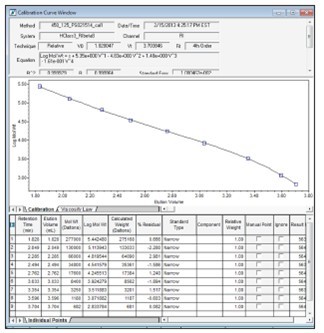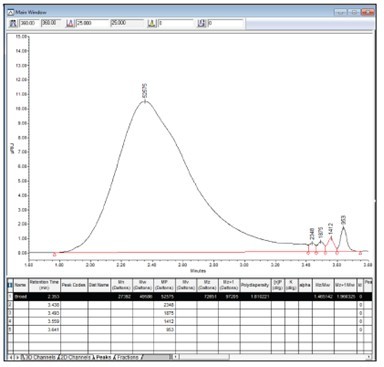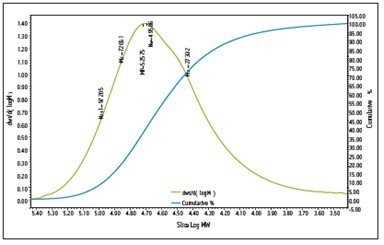Jeremy C. Shia, Mia Summers and Kenneth J. Fountain
Waters Technology (Shanghai) Co., Ltd.
purpose
Demonstrate the use of Empower® software to efficiently and simply process GPC/APC data, calculate molecular weight parameters and efficiently characterize polymer samples.
background
Empower Software is a regulatory compliance chromatography software (CDS) package from Waters for advanced data collection, management, processing, reporting and distribution. It is used in many analytical laboratories for a wide range of applications involving pharmaceutical, chemical, food and environmental analysis. In addition, the software package offers powerful processing options for polymer gel permeation chromatography. Based on recent advances in instrument manufacturing, the Waters® ACQUITY® Ultra High Performance Polymer Chromatography (APCTM) system combines with sub-3μm particle column technology to deliver polymers (especially low molecular weight polymers) at unprecedented speeds. Characterization by ultra-high resolution chromatography. To illustrate the performance of Empower, we analyzed a polysulfone sample using the Waters ACQUITY APCTM system with two columns in series. Molecular weight calibration was performed using a narrow set of polystyrene standards.
A powerful and efficient tool for calculating molecular weight distribution and automatically generating characterization data for polymer samples
Data calibration was performed using Empower 3 software with the GPC option and a calibration curve was generated. Finally, the molecular weight parameters of this polysulfone sample were again automatically determined based on the polysulfone calibration curve to characterize the polymer.

Figure 1. Calibration curve for polysulfone standards generated using Empower3 software with the GPC option.
solution
The GPC/APC system is calibrated in two ways: relative calibration and pervasive calibration. Relative calibration can be achieved by comparing an unknown polymer to a polymer that is well characterized over a broad molecular weight distribution or a group of polymers having a narrower molecular weight distribution. This is typically based on data collected from various detectors including, but not limited to, UV, ELSD, RI, and CAD. Pervasive calibration requires the use of molecularly sensitive detectors such as viscometers, small angle light scattering detectors (LALLS) or multi-angle light scattering detectors (MALLS). The Empower 3 software with GPC option can accommodate a variety of calibration modes.
This example illustrates the calibration of the ACQUITY APC system by analyzing a set of narrowly distributed polystyrene standards. The molecular weight of each polystyrene standard at the peak (Mp) is used to determine the molecular weight relative to the retention time or retention volume. Data processing methods can be easily created using a data processing method creation wizard, or you can manually set custom integration events.
Once the data is automatically integrated and quantified, a calibration curve is generated immediately. Figure 1 shows a polystyrene calibration curve obtained by plotting the Mp log value versus the retention volume. Once the calibration curve is generated, the sample is processed immediately, and the molecular weight distribution is calculated and displayed in a conventional Empower data sheet, as shown in Figure 2. Further data processing using the GPC option in the Empower 3 software allows the user to visualize the polymer data in a variety of ways, including the simultaneous display of dwt/d (logM) and cumulative % in the same graph relative to the intra-slice molecular weight logarithm The molecular weight distribution of the change is shown in Figure 3. Analyze data output or use existing templates or custom report templates to generate a report containing any or all of the results, including molecular weights, chromatograms, profiles, and calibration curves.

Figure 2. Polysulfone chromatogram. Molecular weight parameters such as Mw, Mn, Mz, and polymer dispersion index are calculated from calibration curves generated using a set of narrowly distributed polystyrene standards.

Figure 3. Molecular weight distribution analysis of a polysulfone sample using a series connected APC XT 450Ã… and 125Ã… columns.
to sum up
We used the ACQUITY APC system to quickly analyze a set of narrow-distributed polystyrene standards and a polysulfone sample and processed the data using Empower 3 software with the GPC option. A relative calibration curve was drawn based on the polystyrene standards injected and the polymer was characterized by software-calculated molecular weight distribution data. The Empower 3 software with GPC option has proven to be both easy to operate and versatile, calculating molecular weight distribution and automatically generating characterization data for polymer samples. Combining the many features of the Empower3 software with the GPC option with the analysis speed and resolution of the ACQUITY APC system provides a powerful and effective tool for efficient characterization of new and existing polymers.
Stainless Steel Sink,Hospital Operating Room Sink,Medical Wash Basin,Hospital Steel Sink
Taizhou Gaogang District Dixin Medical Equipment Co., Ltd. , https://www.dixinmedical.com